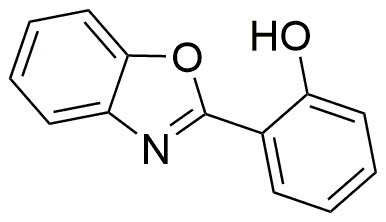2-(2-Hydroxyphenyl)benzoxazole is widely utilized in research focused on:
- Fluorescent Dyes: This compound is used as a fluorescent dye in biological imaging. Its ability to emit light upon excitation makes it valuable for tracking cellular processes in live cells.
- Optical Sensors: It serves as a key component in optical sensors, particularly in detecting environmental pollutants. Its sensitivity to changes in light conditions allows for real-time monitoring of air and water quality.
- Pharmaceutical Development: In the pharmaceutical industry, it plays a role in the development of new drugs, particularly those targeting specific diseases. Its unique chemical structure can be modified to enhance therapeutic effects.
- Polymer Additives: This compound is incorporated into polymers to improve their thermal stability and UV resistance, making it useful in the production of durable materials for outdoor applications.
- Research in Photochemistry: It is extensively studied in photochemistry for its ability to undergo photochemical reactions. This property is leveraged in developing new materials for solar energy applications.
General Information
Properties
Safety and Regulations
Applications
2-(2-Hydroxyphenyl)benzoxazole is widely utilized in research focused on:
- Fluorescent Dyes: This compound is used as a fluorescent dye in biological imaging. Its ability to emit light upon excitation makes it valuable for tracking cellular processes in live cells.
- Optical Sensors: It serves as a key component in optical sensors, particularly in detecting environmental pollutants. Its sensitivity to changes in light conditions allows for real-time monitoring of air and water quality.
- Pharmaceutical Development: In the pharmaceutical industry, it plays a role in the development of new drugs, particularly those targeting specific diseases. Its unique chemical structure can be modified to enhance therapeutic effects.
- Polymer Additives: This compound is incorporated into polymers to improve their thermal stability and UV resistance, making it useful in the production of durable materials for outdoor applications.
- Research in Photochemistry: It is extensively studied in photochemistry for its ability to undergo photochemical reactions. This property is leveraged in developing new materials for solar energy applications.
Documents
Safety Data Sheets (SDS)
The SDS provides comprehensive safety information on handling, storage, and disposal of the product.
Product Specification (PS)
The PS provides a comprehensive breakdown of the product’s properties, including chemical composition, physical state, purity, and storage requirements. It also details acceptable quality ranges and the product's intended applications.
Certificates of Analysis (COA)
Search for Certificates of Analysis (COA) by entering the products Lot Number. Lot and Batch Numbers can be found on a product’s label following the words ‘Lot’ or ‘Batch’.
*Catalog Number
*Lot Number
Certificates Of Origin (COO)
This COO confirms the country where the product was manufactured, and also details the materials and components used in it and whether it is derived from natural, synthetic, or other specific sources. This certificate may be required for customs, trade, and regulatory compliance.
*Catalog Number
*Lot Number
Safety Data Sheets (SDS)
The SDS provides comprehensive safety information on handling, storage, and disposal of the product.
DownloadProduct Specification (PS)
The PS provides a comprehensive breakdown of the product’s properties, including chemical composition, physical state, purity, and storage requirements. It also details acceptable quality ranges and the product's intended applications.
DownloadCertificates of Analysis (COA)
Search for Certificates of Analysis (COA) by entering the products Lot Number. Lot and Batch Numbers can be found on a product’s label following the words ‘Lot’ or ‘Batch’.
*Catalog Number
*Lot Number
Certificates Of Origin (COO)
This COO confirms the country where the product was manufactured, and also details the materials and components used in it and whether it is derived from natural, synthetic, or other specific sources. This certificate may be required for customs, trade, and regulatory compliance.


